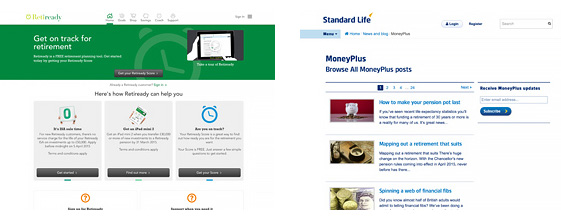One of the primary goals at Space01 is to ensure that your customers have a seamless online experience accessing the information they need and – if required – transacting as easily and efficiently as possible.
At the same time, your users, customers and clients should appreciate the experience, the information and the services offered by your brand with the result that they are happy to stay with your firm or, for their more transactional needs, to come back and do business with you again.
The clearest example today of these two related challenges comes from the imminent Freedom and Choice reforms in pensions. Establishing your brand and your website as a trusted source of information in this area will allow your business to reap substantial rewards.
But the reforms also throw up some very interesting challenges in terms of the complexity of the information, the regulations and the ability to transact.
We believe that an appreciation of the big trends in financial services and in digital marketing and communications will help us to help you frame your online strategies.
So in the next two posts, following a little inter-consultancy debate, we are going to identify a dozen trends to watch, first in financial services and second more generally in digital marketing.
For anyone working in financial services, the first five may be pretty much as expected though we have added our view of the implications; the second group of seven digital trends is a little less expected. But, as ever, we would very much like to hear your views.
Five big trends in financial services
The pension income reforms
We all know that Freedom and Choice in pensions is happening and soon. The biggest unknown is how consumers will react including those several hundred thousand who have delayed their annuity decision in the last 12 months. No-one can say with absolute conviction what people will do, but at Space01 we have some idea, having talked to lots of consumers in the course of our research since last year’s Budget (see our White Paper). We have identified some misunderstandings, but most people are determined to do the right thing with their money, mainly by not running out of it. Our view is the big pension providers and advisers will rise to the challenge of assisting people to take best advantage of the reforms. Income drawdown will become much more common, but with investors getting more and better information.
As for annuities, we believe advisers and annuity providers will find a way to restate the case for buying an annuity. Many people still want an element of a guarantee to their income, though it could mean they may buy an annuity later in life. It might even get easier now the public don’t feel as if they have been forced into the decision. The risk is that people blow their money or invest in illiquid and risky property schemes or even fraudulent ones. Regulated financial services can only do so much, though it does mean more pressure on Pension Wise powered by the Pensions Advisory Service and Citizens’ Advice. We wait to see if they can cope.
One last minute change in terms of systems comes with the FCA’s ‘second line of defence’ requirements. We await the details though for providers, hopefully, it will involve adjusting their message rather than radically altering it.
Department for Work & Pensions
Auto-enrolment hits the small business world
Auto-enrolment rolls out to small businesses of 30 employees or fewer at the start of this summer. This may include those business owners who are among the most reluctant to participate. Getting the message right and making the process as easy as possible will be crucial. Many big pension players will not serve this market and it may be down to smaller advisers and accountants. A big challenge is making the journey as easy as possible but doing so cost-effectively. It is 2016 before the minimum contributions rise above 1%. Will opt outs rise and can communications minimise the number? A separate AE question is whether the industry can use all these new connections with employees and employers to offer other benefits.
Economics continues to drive uncertainty
The global economic situation is still many years away from anything we could call normal, but in recent months things have become exceptionally volatile as well. This has an impact on savings, investment and even housing (with Central London property arguably a safe haven for the world’s rich with implications good and bad for everyone else). Challenging developments include the Swiss franc soaring, the Greeks voting for an end to euro-austerity and a renegotiation of their debts, the European Central Bank announcing quantitative easing of up to 1 trillion euros until 2016 sending the euro plunging. Bank of England Governor Mark Carney warns the intervention could distort markets. Meanwhile inflation in the UK is close to record levels at 0.5%. Good for borrowers, bad for savers.
In summary, there is a huge amount to talk about, but what to tell investors? This is very challenging, but if you can help clients and customers understand what is going on and set it in the framework of a sensible investment strategy, it could bring huge dividends in terms of building trust and establishing expertise.

MoneyPlus from Standard Life, Retireready from Aegon
The advice, guidance and information boundary
We are seeing more businesses aiming to exploit this area, using the web to fill the advice gap and helping inform and even, on occasions, warning people about doing the wrong thing. But what is advice and what is information?
There are very clear examples of quality information such as Standard Life’s MoneyPlus blog, examples of information and guidance with a strong emphasis on encouraging action such as Retiready from Aegon, while regulated online advice propositions from IFAs such as Wealth Wizards, may begin to gain ground. The biggest player is Hargreaves Lansdown which says it is offering telephone advice.
Yet with all this movement, at Space01 we don’t think the recent finalised guidance from the regulator represents a big shift in thinking, even if the rules on what is and isn’t advice are a little clearer. So far the old rules still apply to this changing market, with implications for anyone with ambitions to make money from filling the advice gap.

Crowdfunding continues to draw the crowds
This year crowdfunding, crowdinvesting and crowd-donating will continue to build on their already substantial momentum. This way of raising funds has huge appeal to start ups, while many people like to help fund a project run by people they see as like-minded peers.
It is winning the hearts and minds of the masses. With the likes of www.kiva.org allowing developing world countries to access funding and Kickstarter changing the way entrepreneurs seek capital and investment, this year we’ll see a big increase in crowd investing, be that investing collectively in business, property or inventions. Once again, there are some barriers to regulated financial services fully embracing the proposition, though new rules last year made things clearer. These projects remain very difficult to fit into a typical risk profiling approach however. Maybe things will change when crowd investing reaches critical mass though some might argue that it has already.
So those are our five big trends driven by legislation, innovation and customers within financial services. We would, as always, love to hear your views about whether we have missed out a big trend or the full implications of one we have identified. In the next post, we range slightly further.
SHARE:


